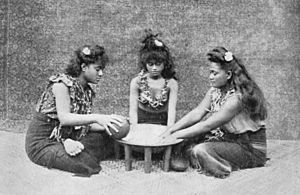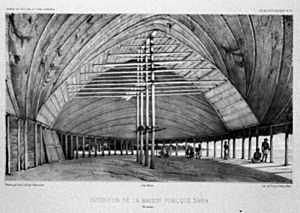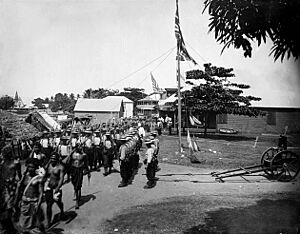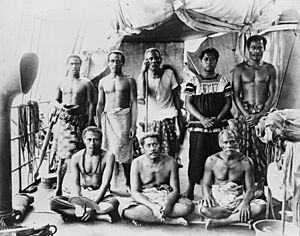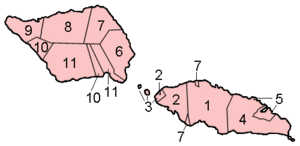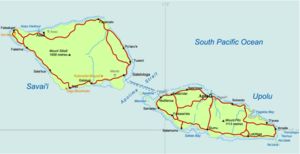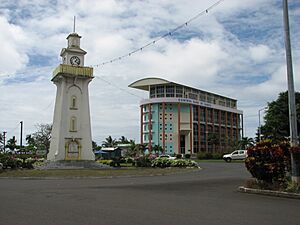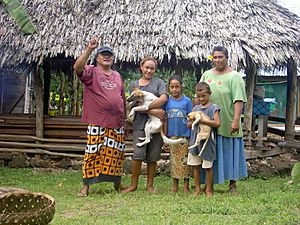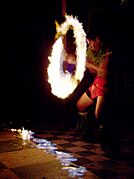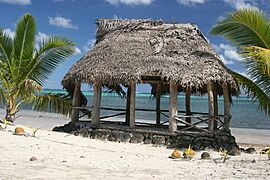Samoa facts for kids
Quick facts for kids
Independent State of Samoa
Malo Saʻoloto Tutoʻatasi o Sāmoa
|
|
|---|---|
|
Motto: Faʻavae i le Atua Sāmoa
"Samoa is founded on God" |
|
|
Anthem: O Le Fuʻa o le Saʻolotoga o Sāmoa
"The Banner of Freedom" |
|

Location of Samoa
|
|
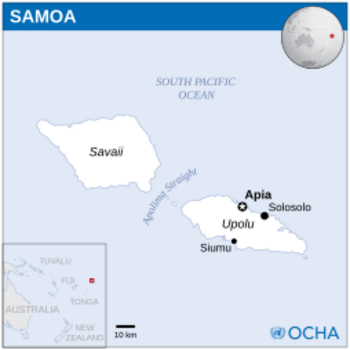
Map of Samoa
|
|
| Capital and largest city
|
Apia 13°50′00″S 171°45′44″W / 13.83333°S 171.76222°W |
| Official languages | Samoan, English |
| Ethnic groups
(2021)
|
|
| Religion
(2021)
|
|
| Demonym(s) | Samoan |
| Government | Unitary parliamentary republic |
| Tuimalealiʻifano Vaʻaletoʻa Sualauvi II | |
| Fiamē Naomi Mataʻafa | |
|
• Assembly Speaker
|
Papaliʻi Liʻo Taeu Masipau |
| Legislature | Legislative Assembly |
| Independence
from New Zealand
|
|
| 14 June 1889 | |
| 16 February 1900 | |
|
• Colonisation by Germany
|
1 March 1900 |
|
• Occupied by New Zealand
|
30 August 1914 |
|
• League mandate
|
17 December 1920 |
|
• UN trusteeship
|
13 December 1946 |
|
• Western Samoa Act 1961
|
1 January 1962 |
|
• Admitted to the United Nations
|
15 December 1976 |
|
• Name change from Western Samoa to Samoa
|
4 July 1997 |
| Area | |
|
• Total
|
2,831 km2 (1,093 sq mi) (167th) |
|
• Water (%)
|
0.3 |
| Population | |
|
• November 2021 census
|
205,557 (176th) |
|
• Density
|
70/km2 (181.3/sq mi) |
| GDP (PPP) | 2024 estimate |
|
• Total
|
|
|
• Per capita
|
$5,962 |
| GDP (nominal) | 2024 estimate |
|
• Total
|
|
|
• Per capita
|
$4,420 |
| Gini (2013) | medium |
| HDI (2022) | high · 116th |
| Currency | Tālā (WS$ ) (WST) |
| Time zone | UTC+13 (WST) |
| Date format | dd/mm/yyyy |
| Driving side | left |
| Calling code | +685 |
| ISO 3166 code | WS |
| Internet TLD | .ws |
Samoa, also known as the Independent State of Samoa, is an island country in Polynesia. It is made up of two main islands, Savai'i and Upolu, plus two smaller islands where people live, Manono and Apolima. There are also several tiny islands that are not inhabited.
Samoa is located in the Pacific Ocean. It is west of American Samoa and northeast of Tonga and Fiji. Its capital and largest city is Apia. About 3,500 years ago, the Lapita people discovered and settled the Samoan Islands. They created the unique Samoan language and Samoan culture.
Samoa is a single parliamentary democracy with 11 main areas. It is a sovereign state and part of the Commonwealth of Nations. In 1976, Samoa joined the United Nations. Early European explorers called the islands "Navigator Islands" because Samoans were skilled sailors. Samoa was a colony of the German Empire from 1899 to 1915. Then, it was controlled by Britain and New Zealand until it became independent on January 1, 1962.
Contents
History of Samoa
How the Islands Formed
The islands of Samoa were formed about 7 million years ago. This happened during the Miocene period. For the last 2 million years, the islands have had volcanic activity.
Early Settlers
Samoa was first settled by the Lapita people. These people came from Island Melanesia and spoke Oceanic languages. The oldest human remains found in Samoa are from about 2,900 to 3,500 years ago. Scientists found these remains at a Lapita site called Mulifanua in 1974.
Samoans kept strong ties with Fiji and Tonga. Old stories and family histories show that people traveled and married between these islands. Important figures in Samoan history include Queen Salamasina and King Fonoti. Nafanua was a famous woman warrior. She was seen as a goddess in ancient Samoan religion.
Today, Samoa is united under two main royal families: the Sā Malietoa and the Sā Tupua. These families hold the four highest titles in Samoa. These titles are Malietoa, Tupua Tamasese, Mataʻafa, and Tuimalealiʻifano. They are very important in the Samoan matai system.
Europeans first came to Samoa in the early 1700s. A Dutchman named Jacob Roggeveen saw the islands in 1722. Later, French explorer Louis Antoine de Bougainville named them the Navigator Islands in 1768. More contact happened after the 1830s. That's when British missionaries, whalers, and traders started to arrive.
The 1800s
American trading and whaling ships visited Samoa often in the 1800s. They came for fresh water, wood, and supplies. They also recruited local men to work on their ships. Christian missionary work began in 1830. John Williams of the London Missionary Society arrived in Sapapali'i.
In the late 1800s, the United States, Germany, and Britain all wanted influence in Samoa. This led to an eight-year civil war. Each country gave weapons and training to different Samoan groups. In March 1889, warships from all three countries gathered in Apia harbor. A big storm on March 15, 1889, destroyed or damaged the warships. This ended the immediate conflict.
The Second Samoan Civil War happened in 1898. Germany, the United Kingdom, and the United States were still fighting over who would control Samoa. The Siege of Apia took place in March 1899. Samoan forces loyal to Prince Tanu fought against rebels loyal to Mataʻafa Iosefo. British and American warships helped Prince Tanu's forces. The rebels were defeated after several days.

The three countries decided to divide the islands. This was done by the Tripartite Convention of 1899. The eastern islands became a territory of the United States, known as American Samoa. The western islands became German Samoa. Britain gave up its claims in Samoa. In return, it received rights in Tonga and the Solomon Islands.
German Rule (1900–1914)
The German Empire ruled the western part of Samoa from 1900 to 1914. Wilhelm Solf was the first governor. In 1908, a peaceful resistance group called the Mau a Pule started. Governor Solf sent their leader, Lauaki Namulau'ulu Mamoe, away to Saipan.
The German government believed it was the only power in the islands. There was no Samoan king. Instead, two advisors called Fautua were appointed. Traditional Samoan governments had less power.
When World War I began in August 1914, New Zealand troops landed on Upolu. They took control from the German authorities without a fight.
New Zealand Rule (1914–1961)
After World War I, New Zealand controlled Western Samoa. This was under a trusteeship from the League of Nations and later the United Nations. During this time, two major events happened.
The Flu Pandemic
Between 1918 and 1919, about one-fifth of Samoa's population died from the influenza epidemic. A ship from Auckland arrived in Samoa in November 1918. The New Zealand administration allowed the ship to dock, even though it should have been quarantined. Within a week, the flu spread quickly. Samoa suffered greatly, with 90% of the population getting sick. Many people died, including 30% of adult men and 22% of adult women.
This pandemic made Samoans lose trust in New Zealand's leadership. Some Samoans even asked for American or British rule instead.
The Mau Movement
The second major event was a protest by the Mau movement. This was a peaceful group that wanted independence. It started in the early 1900s on Savai'i. Its first leader was Lauaki Namulauulu Mamoe. He was sent away by the German governor.
By 1918, many Samoans were unhappy with New Zealand's rule. They blamed the New Zealand government for rising prices and the flu epidemic. By the late 1920s, the independence movement had strong support. One leader was Olaf Frederick Nelson, a merchant of Samoan and Swedish background. He was sent away but kept helping the movement.
On December 28, 1929, the new Mau leader, High Chief Tupua Tamasese Lealofi, led a peaceful protest in Apia. Police tried to arrest a leader, and a fight started. Police began shooting into the crowd. They even used a machine gun. Mau leader Tupua Tamasese Lealofi III was killed while trying to calm the crowd. Ten other people died, and about 50 were injured. This day became known as Black Saturday.
The New Zealand authorities banned the Mau organization. Many Mau men went into hiding. New Zealand sent marines and military police to find them. Villages were raided. In March, Mau leaders agreed to stop protesting after talks with New Zealand officials.
However, Mau supporters continued to be arrested. Women then stepped up to lead protests. The situation changed when the Labour Party won the election in New Zealand in 1935. They sent a "goodwill mission" to Samoa in 1936. This mission recognized the Mau as a real political group. Olaf Nelson was allowed to return. In September 1936, Samoans voted for their local representatives for the first time. Mau members won most of the seats.
Becoming Independent
The Samoan independence movement worked hard for freedom. On November 24, 1961, New Zealand passed a law. This law ended its control over Samoa. Samoa became the Independent State of Western Samoa on January 1, 1962. It was the first small island country in the Pacific to gain independence. Samoa signed a friendship treaty with New Zealand that year. On August 28, 1970, Western Samoa joined the Commonwealth of Nations. Even though independence was in January, Samoa celebrates its Independence Day on June 1.
Fiamē Mataʻafa Faumuina Mulinuʻu II, a high-ranking chief, became Samoa's first prime minister. Two other chiefs, Tupua Tamasese Meaʻole and Malietoa Tanumafili II, became joint heads of state for life.
On December 15, 1976, Western Samoa joined the United Nations. It asked to be called the Independent State of Samoa there.
On July 4, 1997, the government changed the country's name from Western Samoa to Samoa. American Samoa protested this change, saying it made their own identity less special.
In 2002, New Zealand's prime minister, Helen Clark, officially apologized for New Zealand's part in the 1918 flu outbreak. This epidemic killed over a quarter of Samoa's population.
On September 7, 2009, Samoa changed its driving side from right to left. This made it like most other Commonwealth countries, like Australia and New Zealand. Samoa was the first country in the 21st century to make this switch.
At the end of 2011, Samoa changed its time zone. It jumped forward by one day, skipping Friday, December 30. This change helped Samoa do business with Australia and New Zealand. Before, Samoa was 21 hours behind Sydney. Now, it is three hours ahead.
In June 2017, Samoa's Parliament changed its constitution. It made Christianity the official state religion.
In September 2019, a measles outbreak caused the deaths of 83 people. The government put a curfew in place in December of that year.
In May 2021, Fiamē Naomi Mataʻafa became Samoa's first female prime minister. Her party, FAST, won the election. This ended the long rule of former Prime Minister Tuilaʻepa Saʻilele Malielegaoi. After some legal issues, she was officially sworn in. This ended a political crisis and Tuilaʻepa's 22-year time as prime minister.
Government and Politics
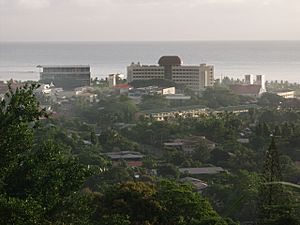
Samoa's government is based on a parliamentary democracy. This system is similar to Britain's. It also includes Samoan customs. The national government is called the Malo.
The head of state of Samoa is called O le Ao o le Malo. Since this position was created, only important chiefs have held it.
The Legislative Assembly, or Fono, is the main law-making body. It has 51 members who serve five-year terms. Forty-nine members are matai (chiefs) elected from different areas. The other two are chosen by non-Samoans. At least 10% of the members must be women. Everyone can vote since 1990. However, only chiefs can run for the Samoan seats. There are over 25,000 chiefs in Samoa, and about 5% are women.
The prime minister is chosen by the assembly. The head of state then appoints them. The prime minister chooses 12 people for the cabinet. These choices are also approved by the head of state.
Important women in Samoan politics include Laʻulu Fetauimalemau Mataʻafa. Her daughter, Fiamē Naomi Mataʻafa, is a chief and became Prime Minister in 2021.
The legal system uses English common law and local customs. The Supreme Court of Samoa is the highest court. The Chief Justice of Samoa is appointed by the head of state.
Administrative Divisions
Samoa has eleven itūmālō (political districts). These districts existed before Europeans arrived. Each district has its own traditional rules and important titles. The main village in each district manages its affairs. It also gives out the district's most important title.
For example:
- Aʻana has its capital at Leulumoega. Its most important royal title is Tuimalealiʻifano.
- Ātua has its capital at Lufilufi. Its main royal titles are Tupua Tamasese and Mataʻafa.
- Tuamasaga has its capital at Afega. Its most important royal title is Malietoa.
The eleven districts are:
- On Upolu
- Tuamasaga (Afega)
- Aʻana (Leulumoega)
- Aiga-i-le-Tai (Mulifanua) (includes Manono, Apolima and Nuʻulopa islands)
- Ātua (Lufilufi) (includes the Aleipata Islands and Nuʻusafeʻe Island)
- Vaʻa-o-Fonoti (Samamea)
- On Savaiʻi
- Faʻasaleleaga (Safotulafai)
- Gagaʻemauga (Saleaula) (parts also on Upolu)
- Gagaʻifomauga (Safotu)
- Vaisigano (Asau)
- Satupaʻitea (Satupaʻitea)
- Palauli (Vailoa)
Geography of Samoa
Samoa is south of the equator, between Hawaii and New Zealand. It is in the Polynesian part of the Pacific Ocean. The total land area is about 2,842 square kilometers. This includes the two large islands, Upolu and Savaiʻi, and eight small islands.
The small islands are:
- Three islands in the Apolima Strait: Manono Island, Apolima, and Nuʻulopa.
- Four Aleipata Islands off Upolu's eastern end: Nuʻutele, Nuʻulua, Namua, and Fanuatapu.
- Nuʻusafeʻe, a very small island off Upolu's south coast.
Most of Samoa's population lives on Upolu, where the capital city Apia is located.
The Samoan islands were formed by volcanism. This means they were created by volcanoes. Only Savaiʻi, the westernmost island, is still volcanically active. The highest point in Samoa is Mount Silisili, which is 1,858 meters high. The Saleaula lava fields on Savaiʻi were formed by volcanic eruptions.
Savaiʻi is the largest Samoan island. It is the sixth-largest Polynesian island. Its population is about 42,000 people.
Climate
Samoa has a warm, tropical climate. The average temperature is 26.5°C (80°F). The main rainy season is from November to April. However, heavy rain can fall in any month.
| Climate data for Apia | |||||||||||||
|---|---|---|---|---|---|---|---|---|---|---|---|---|---|
| Month | Jan | Feb | Mar | Apr | May | Jun | Jul | Aug | Sep | Oct | Nov | Dec | Year |
| Mean daily maximum °C (°F) | 30.4 (86.7) |
30.6 (87.1) |
30.6 (87.1) |
30.7 (87.3) |
30.4 (86.7) |
30.0 (86.0) |
29.5 (85.1) |
29.6 (85.3) |
29.9 (85.8) |
30.1 (86.2) |
30.3 (86.5) |
30.5 (86.9) |
30.2 (86.4) |
| Mean daily minimum °C (°F) | 23.9 (75.0) |
24.2 (75.6) |
24.0 (75.2) |
23.8 (74.8) |
23.4 (74.1) |
23.2 (73.8) |
22.6 (72.7) |
22.8 (73.0) |
23.1 (73.6) |
23.4 (74.1) |
23.6 (74.5) |
23.8 (74.8) |
23.5 (74.3) |
| Average rainfall mm (inches) | 489.0 (19.25) |
368.0 (14.49) |
352.1 (13.86) |
211.2 (8.31) |
192.6 (7.58) |
120.8 (4.76) |
120.7 (4.75) |
113.2 (4.46) |
153.9 (6.06) |
224.3 (8.83) |
261.7 (10.30) |
357.5 (14.07) |
2,965 (116.72) |
| Source: World Meteorological Organization (UN) | |||||||||||||
Ecology
Samoa is part of the Samoan tropical moist forests area. Since people started living there, about 80% of the lowland rainforests have disappeared. In this area, about 28% of plants and 84% of land birds are found nowhere else in the world.
Economy of Samoa
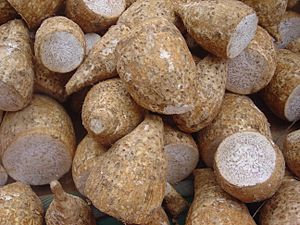
The United Nations has called Samoa an economically developing country since 2014. In 2017, Samoa's total economic output was about $1.13 billion U.S. dollars. The services sector makes up most of Samoa's economy (66%). Industry is 23.6%, and agriculture is 10.4%. About two-thirds of the people work in agriculture.
The Central Bank of Samoa manages Samoa's money, which is called the Samoan tālā.
Samoa's economy has always relied on farming and fishing. Today, money from other countries, money sent home by Samoans living abroad, and farm exports are very important. Agriculture employs most workers and provides 90% of exports. These exports include coconut cream, coconut oil, and noni juice.
About 60% of Samoa's electricity comes from clean sources like hydro, solar, and wind power. The rest comes from diesel generators. The Electric Power Corporation aimed for 100% clean energy by 2021.
Agriculture
Before German rule, Samoa mainly produced copra (dried coconut meat). German businesses started large farms for cocoa beans and rubber. They brought in workers from China and Melanesia. When rubber prices dropped after World War I, New Zealand encouraged Samoa to grow bananas.
Samoa can grow many tropical and subtropical crops because of its different altitudes. About 24.4% of the land is used for crops.
The main farm products are copra, cocoa beans (for chocolate), and bananas. Samoan cocoa beans are known for their high quality. Coffee also grows well in Samoa.
Other farm products have not been as successful. Sugarcane was grown by Germans in the early 1900s. You can still see old train tracks from those times near Apia. Pineapples grow well but are mostly eaten locally, not exported.
Transport
Samoa has an international airport called Faleolo International Airport. It is about 25 miles west of Apia.
Daily ferry services connect the two main islands, Upolu and Savai’i. These ferries carry both cars and people. The trip takes about 60-90 minutes.
People of Samoa
In 2021, Samoa had a population of 205,557 people. About three-quarters of the people live on the main island of Upolu.
Most of the population (96%) are Samoans. About 2% are both Samoan and New Zealander.
Languages
Samoan (Gagana Fa'asāmoa) and English are the official languages. More people speak Samoan than English in Samoa. Samoan Sign Language is also used by deaf people. In 2017, basic Samoan Sign Language was taught to police and the public. This was to help include everyone.
Religion
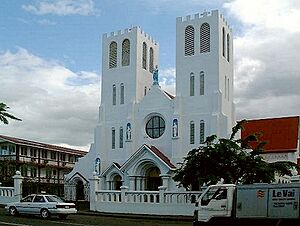
Since 2017, the Samoan Constitution states that "Samoa is a Christian nation founded of God the Father, the Son and the Holy Spirit".
According to the 2021 Census, most people in Samoa are Christian. The largest groups are:
- Christian Congregational Church of Samoa (27%)
- Roman Catholic (19%)
- The Church of Jesus Christ of Latter-day Saints (18%)
- Methodist (12%)
- Assembly of God (10%)
Samoa is home to one of the nine Baháʼí Houses of Worship in the world. It was finished in 1984 and is located in Tiapapata, near Apia.
Education
The Samoan government provides eight years of free primary and secondary education. It is required for children up to age 16.
Samoa's main university is the National University of Samoa, started in 1984. There are also branches of the University of the South Pacific and the Oceania University of Medicine.
Education in Samoa is very good. A 2012 report said that 99% of Samoan adults can read and write. Samoa is doing well in providing primary education. However, there is still work to do for secondary education.
Culture of Samoa
Faʻa Sāmoa, or the traditional Samoan way of life, is still very important. It is one of the oldest Polynesian cultures. Faʻa Sāmoa has developed over 3,000 years. It has kept its customs, social systems, and language strong, even with centuries of European influence.
Important cultural events include the Samoa 'ava ceremony. This is a serious ritual for special occasions, like giving out matai (chiefly) titles. Finely woven mats called 'ie toga are also very valuable culturally.
Samoan mythology has many gods and creation stories. There are also legends like Tagaloa and the war goddess Nafanua. Another famous legend is about Sina and the Eel. This story explains how the first coconut tree came to be.
Many Samoans are spiritual and religious. They have blended Christianity with fa'a Sāmoa. Old beliefs still exist alongside Christianity, especially in traditional customs. Samoan culture focuses on vāfealoa'i, which means relationships between people. These relationships are based on respect, or fa'aaloalo. Most Samoans (98%) are Christian.
Some Samoans live a communal life. They do activities together. For example, traditional Samoan fale (houses) are open with no walls. They use blinds made of coconut palm leaves for night or bad weather.
The Samoan siva dance has gentle body movements that tell a story. Samoan male dances can be more energetic. The sasa is another traditional dance. Dancers perform fast, synchronized movements to the beat of wooden drums. The fa'ataupati or slap dance is performed by men. They create rhythms by slapping different parts of their bodies. This dance may have come from slapping insects.
Building traditional Samoan fale was a special skill. It was done by Tufuga fai fale (master builders). This skill was connected to other Samoan art forms.
Tattooing
Samoans have important and unique tattoos, like other Polynesian cultures. For males, the tattoo is called the Pe'a. It has detailed patterns that cover from the knees up to the ribs. A man with a Pe'a is called a soga'imiti. A Samoan girl or teine gets a malu. This tattoo covers from just below her knees to her upper thighs.
Contemporary Culture
Albert Wendt is a famous Samoan writer. His novels tell Samoan stories. His book Flying Fox in a Freedom Tree was made into a film in New Zealand in 1989.
Sia Figiel won an award in 1997 for her novel "Where We Once Belonged". Momoe Malietoa Von Reiche is a well-known poet and artist. Tusiata Avia is a performance poet.
Other Samoan poets and writers include Sapa'u Ruperake Petaia and Savea Sano Malifa.
In music, popular local bands include The Five Stars and Punialava'a. The Yandall Sisters had a number one hit in New Zealand in 1974.
King Kapisi was the first hip hop artist to win a major New Zealand music award in 1999. His music video was filmed in Savai'i. Other successful Samoan hip hop artists include Scribe and Savage.
Lemi Ponifasio is a director and choreographer known internationally for his dance company, MAU. Neil Ieremia's company, Black Grace, has also performed around the world.
Hip hop has greatly influenced Samoan culture, especially among young people. Dance, both traditional and modern, remains a key part of Samoan culture.
The arts group Tautai Pacific Arts Trust supports Pacific artists. Important Samoan contemporary artists include Fatu Feu'u and Michel Tuffery.
Director Sima Urale is a filmmaker. Her short film O Tamaiti won an award in 1996. The 2011 film The Orator was the first fully Samoan film. It was shot in Samoa, in the Samoan language, with a Samoan cast. It received much praise at film festivals.
Sports in Samoa
The main sports in Samoa are rugby union, Samoan cricket, and netball. Rugby union is the national sport. Volleyball is also popular in villages.
Rugby union is very popular in Samoa. The national team, called the Manu Samoa, often plays well against bigger countries. Samoa has played in every Rugby World Cup since 1991. They reached the quarter-finals in 1991 and 1995. They also won the Wellington and Hong Kong Rugby Sevens in 2007. The prime minister even declared a national holiday to celebrate! They were also the IRB World Sevens Series Champions in 2010.
Many Samoans play for the New Zealand rugby team.
The national rugby league team reached the quarter-finals of the 2013 Rugby League World Cup. Many Samoans play in rugby leagues in Britain, New Zealand, and Australia. Samoa reached the final of the 2021 Rugby League World Cup to play Australia.
Samoans are also well-known in boxing, kickboxing, wrestling, and sumo. Some Samoan sumo wrestlers, like Musashimaru and Konishiki, reached the highest ranks.
American football is sometimes played in Samoa. It is very popular in American Samoa. About 30 ethnic Samoans play in the National Football League. An article from 2002 said that a Samoan male is 40 times more likely to play in the NFL than a non-Samoan American.
Images for kids
-
Robert Louis Stevenson's birthday celebration at Vailima, 1894
See also
 In Spanish: Samoa para niños
In Spanish: Samoa para niños




